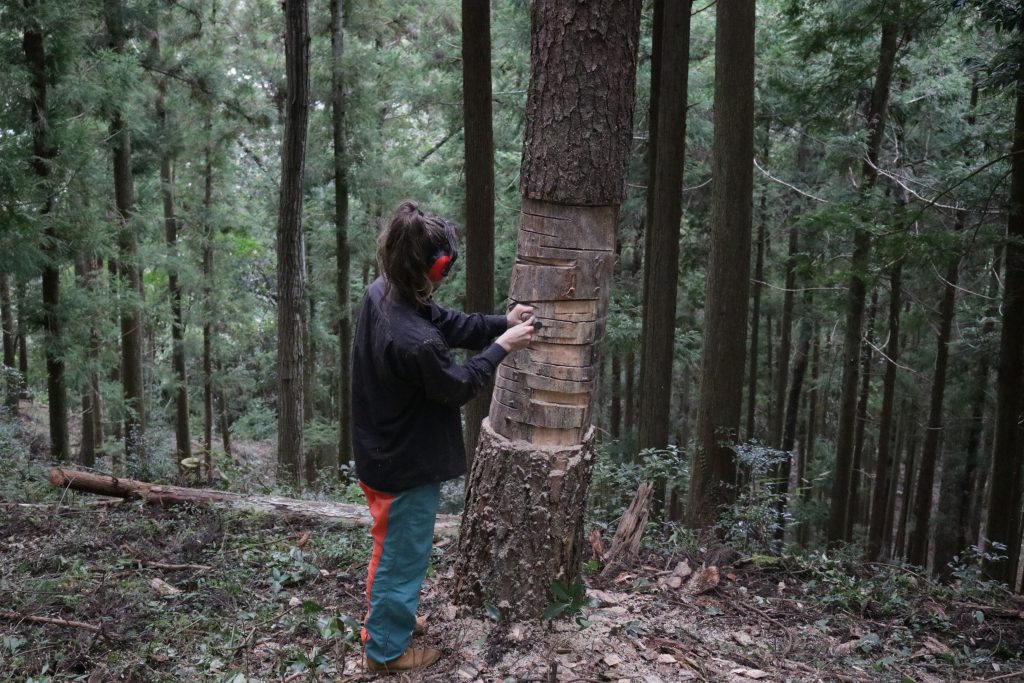
Domestic-Wild ドメスティックワイルド
タイトル|“アリ”、“ワイルドハート”
日本における森林整備や保護活動、また、長寿で神聖なる木々を敬う精神は、賞讃すべきことです。日本語の「カミ」は、神を世界や生命の絶対的な創始者だと指定していませんが、この背景には、創造者と創造されたものの間に違いはなく、両方が創始者であり、また創造物でもあるという考えがあるからです。自然にふれることは神に近くなるということ、私はこれらの枯れた木をその中心部(ハート)に達するまで彫り刻みました。
私はここに制作した作品の意味を説明することはしません。なぜなら、それは作品を見れば自ずと明らかになるはずだから、そして、鑑賞者一人一人の心にその想いが届くと幸いです。
ここでは、これらの作品制作に影響を与えたインスピレーションについてのみ、お話ししたいと思います。
一つ目の枯れ木作品のタイトルはTermites(アリ)です。
作品に近づけば、すぐにその意味するところが分かるでしょう。神山町内の小学校で、同じテーマの課外授業を行ったので、児童たちにも容易に理解してもらえることだと思います。
もう一方の枯れ木作品のタイトルはWild Heart(ワイルドハート)です。
球形ほど、シンプルで、素朴、かつ、力を凝縮させる幾何学的形状は他にありません。原子、細胞、子宮、目、太陽、これらはすべて球形、だから、球形は創造を象徴する形だと言えます。
一方、フクシア(フューシャ)ピンクは日欧で、人間が山林等の目印として使う色、枯れ木や伐採する木、林道などの目印に使われています。明らかに、ピンクは人間による自然への介入を示す色だと言えます。(さらに、このピンク色は、今後、私たちにとって、ニコライさんの代名詞となることでしょう。ニコライさん、この作品は、私たちからあなたへの感謝の印だと思ってください。あなたは、私たちにとって、インスピレーションの源であり、制作の糸口(&テープ?)を与えてくれました。ニコライさんピンクをパントン世界標準カラーに導入したいくらいです。)
ここ神山で、枯れ木の幹の中心部まで彫り刻み、これらふたつの枯れ木に新たな生命を芽吹かせました。この作品により、日本人の木々への思いが深まればと願います。
アリアン・パトゥ―(ドメスティックワイルド)
www.arianepatout.com
www.domestic-wild.com
“Termaites”という言葉は、一般的には木や材、繊維類などを食害する雑食性昆虫としての“シロアリ”と和訳され、多くの人にとって日本語のそれが持つのは、害虫というイメージで捉えられるのに対して、アリアンの使う”Termites”には、森林地帯に生息し、木の中に巣をつくり、トンネルを掘る“オオアリ属”も含む言葉とするため、解釈の差と“シロアリ”という言葉の持つ先入観を避けるため、アーティストと相談の上、“アリ”とした。
“Termites”, “Wild Heart”
Domestic-Wild
"The care and protection of forests in Japan, and the respect for long-lived and sacred trees, is admirable.
The Japanese term Kami does not designate divinities as absolute beings creators of the world and life since it makes no difference between the Creative Being and the created. Both things are Creator and Creation at the same time.
Contact with nature is being close to divinity.
I have carved into these dead trees until I reached their hearts.
I would not like to explain the meaning of these creations, because they should explain it themselves, and hopefully penetrate the heart of each one of you.
-I can only tell you about the inspiration that drove them:
We’re going to call the intervention on that dead tree: Termites.
It is a metaphor that you will quickly understand when you approach it. Even the children from Kamiyama school can also explain something to you about it since we did a workshop with them based on this topic.
We’re going to call the intervention on this other dead tree: Wild Heart.
There is no other simpler, more primitive geometric shape that condenses as much power as the sphere.
The sphere is the primary geometric shape of nature.
The atoms are round, the cells, the uterus, the eye and the sun…so the sphere is the shape that represents creation.
On the other hand, fuxia pink is the color that humans use to mark and mark forests, here in Japan as well as in Europe. The color pink is used to mark trees that are dead, those that need to be cut, to mark paths or areas. Definitely the color pink is the color of human domestication in nature.
(On the other hand, the color pink will also be for us from now on the representation of Nikkolai San. Nikkolai San: you can take it as a tribute from us and know that you have been a source of inspiration, that you have given us the thread, or the ribbon, to start this creation. We are even going to introduce the color Nikkolai San Pink into the universal pantone of colors.)
Here in Kamiyama, we have given new life to these two dead trees, sculpting their trunk to reach their hearts and thus, in some way, consolidate the forest in the hearts of the Japanese."
Ariane Patout
/////
Domestic-Wild
スペイン系フランス人アーティスト、アリアーヌ・パトゥーと、ドイツ系スイス人のデザイナー、ルネ・ミュラーによるアーティストユニット。
2012年、初の共同芸術プロジェクト「ワイルド・チェア」が生まれ、FAD建築賞(2014年)とヴァルドレックス彫刻ビエンナーレ賞(2016年)を受賞。以後、共に制作を続け、その作品で世界を魅了している。
アーティストとして、手付かずの自然や、五感を使って身の回りの環境や自分自身を新たに感知する人々へ敬意を表しながら、場所の本質を探求し、構想と実行可能な選択肢を織り交ぜ、芸術的な手法で場所を再構成することに情熱を持って取り組んでいる。
www.arianepatout.com
www.domestic-wild.com